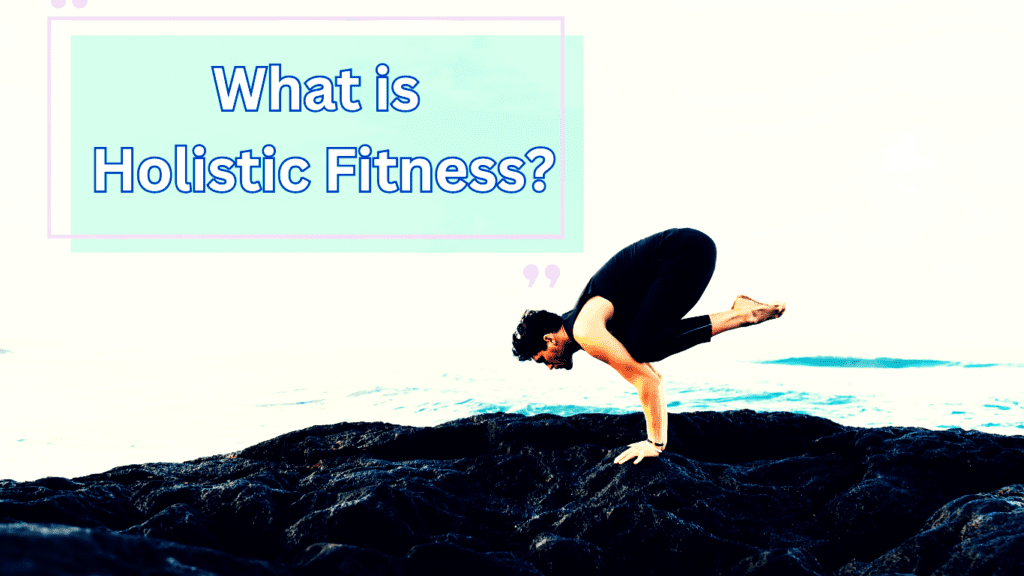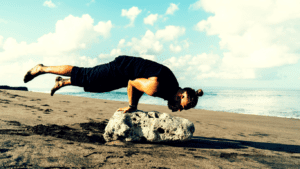Understanding What is Holistic Fitness
In this article, we’ll explore what is holistic fitness and how it can transform your overall well-being, making you feel more vibrant and balanced.
Have you ever wondered why some people seem to radiate vitality, not just in their physical appearance but in their overall demeanor? You might think it’s just a matter of hitting the gym regularly, but there’s something more profound at play. This secret isn’t a new diet or the latest workout trend—it’s called holistic fitness.
So, what is holistic fitness? Imagine your body as a complex machine, but not just any machine—a finely tuned orchestra. Each instrument, from your physical muscles to your mental faculties and emotional well-being, must work in harmony to produce a symphony of health. Holistic fitness is about achieving this balance. It recognizes that true fitness encompasses more than just physical strength or endurance; it integrates mind, body, and spirit into a unified approach to health.

In today’s fast-paced world, where stress levels are sky-high and our time is often stretched thin, holistic fitness is more relevant than ever. The concept goes beyond the typical routines of hitting the gym or going for a run. It includes practices that nurture your mental health, like meditation and mindfulness, which help reduce stress and improve focus. It also involves emotional well-being, ensuring you have healthy ways to express and process your emotions, which is crucial for long-term health and happiness.
Why is this comprehensive approach so important now? For starters, the pressures of modern life have made chronic stress a common experience for many. This kind of stress doesn’t just affect your mood—it can lead to serious health issues like hypertension, weakened immune function, and even chronic diseases. By adopting a holistic fitness approach, you address these issues from multiple angles. Physical exercise is well-known to reduce stress levels by releasing endorphins, but combining it with mental practices like mindfulness can amplify these benefits, creating a more profound sense of well-being.
Moreover, holistic fitness encourages you to listen to your body and understand its signals. Instead of pushing through pain or ignoring signs of fatigue, this approach teaches you to respect your body’s limits and needs. This can prevent injuries and promote a more sustainable way of maintaining fitness. For instance, incorporating yoga or tai chi can improve flexibility and strength while also offering mental clarity and relaxation, providing a balanced workout that feels good rather than punitive.
Another key aspect of holistic fitness is nutrition. Rather than focusing solely on calorie counting or specific diets, this approach promotes eating for overall health. It encourages consuming whole, nutrient-dense foods that fuel your body and mind. Understanding how different foods affect your energy levels, mood, and even sleep patterns can transform your relationship with eating, making it a source of joy and nourishment rather than stress.
The social component is also vital. Holistic fitness often includes building a supportive community around you. Whether it’s a group of friends who join you for a hike, a yoga class that meets weekly, or even a virtual community of like-minded individuals, having social support can significantly enhance your motivation and enjoyment of your fitness journey. It fosters a sense of belonging and accountability, which are essential for long-term success.
So, what is holistic fitness in its essence? It’s a lifestyle. It’s about creating a balanced, fulfilling life where physical, mental, and emotional health are interwoven. It rejects the notion that you have to sacrifice one aspect of health to achieve another. Instead, it promotes the idea that a well-rounded approach leads to the best results. It’s not about quick fixes or extreme measures; it’s about sustainable, enjoyable practices that you can integrate into your daily life.
Subscribe And Get Our Free E-Book:Unlocking The Power Of Nutrition-Supplements, Substitutes, and Superfoods!
Adopting a such fitness approach can also lead to improved self-awareness. As you tune into your body’s needs and responses, you become more attuned to what makes you feel good, energized, and at peace. This self-awareness can extend beyond fitness, improving other areas of your life such as relationships, work, and personal goals.
In summary, what is holistic fitness? It’s an approach to health and well-being that considers the whole person. It integrates physical exercise, mental health practices, emotional well-being, nutrition, and social connections. It’s about balance, sustainability, and finding joy in the process of becoming the best version of yourself. In a world where we’re often pulled in many directions, holistic fitness offers a path to harmony and vitality, helping us live more fully and authentically.
The Concept of Holistic Fitness
The concept of holistic fitness has deep roots, dating back centuries to ancient civilizations that understood the interconnectedness of mind, body, and spirit. Historical records from cultures such as the ancient Greeks and Chinese reveal an early appreciation for a balanced approach to health. The Greeks, for instance, emphasized the importance of physical exercise, mental discipline, and spiritual practices, while traditional Chinese medicine integrated physical health with emotional and spiritual well-being. Over time, these ancient practices evolved, blending with modern science to form the foundation of what we now recognize as holistic fitness.

The philosophical foundations of holistic fitness are built on the principle that true health is not merely the absence of disease but a state of complete physical, mental, and emotional well-being. This philosophy is rooted in several key principles. Firstly, it emphasizes balance—the idea that all aspects of an individual’s life must be in harmony. Secondly, it focuses on individuality, acknowledging that each person’s path to health is unique and should be tailored to their specific needs and circumstances. Lastly, it promotes sustainability, advocating for practices that can be maintained throughout one’s life, rather than short-term fixes.
Understanding what is holistic fitness involves recognizing its departure from traditional fitness approaches. Traditional fitness often prioritizes physical appearance and performance, focusing heavily on specific metrics like weight, body fat percentage, and muscle gain. While these metrics are important, they represent only a fraction of the broader picture of health. Holistic fitness, in contrast, takes a more comprehensive view. It values not just the body but also the mind and emotions, aiming to create a balanced, fulfilling life.
One of the major differences between holistic fitness and traditional fitness is the approach to exercise. Traditional fitness programs might emphasize high-intensity workouts and strict routines designed to achieve specific physical goals. Holistic fitness, however, encourages variety and balance in physical activities. It integrates different forms of exercise, such as strength training, cardiovascular workouts, flexibility exercises, and relaxation techniques like yoga and tai chi. This variety not only helps to prevent boredom and burnout but also ensures that all aspects of physical health are addressed.
Another significant aspect of holistic fitness is its focus on mental and emotional health. Traditional fitness often overlooks these areas, concentrating primarily on physical outcomes. Holistic fitness, however, recognizes that mental and emotional well-being are crucial for overall health. Practices such as mindfulness, meditation, and breathing exercises are incorporated to help manage stress, improve focus, and foster a positive mindset. This holistic approach acknowledges that a healthy mind is essential for a healthy body, and vice versa.
Nutrition is also viewed differently in holistic fitness. Rather than focusing solely on calories, macronutrients, or specific diets, holistic fitness promotes eating for overall health and well-being. This means choosing foods that nourish the body, support mental clarity, and enhance emotional stability. It encourages a balanced diet rich in whole, nutrient-dense foods, while also allowing for flexibility and enjoyment, understanding that food is not just fuel but also a source of pleasure and social connection.
Furthermore, holistic fitness values rest and recovery as much as it does active exercise. It recognizes that adequate sleep and downtime are critical for the body to repair and rejuvenate. Traditional fitness regimens might push for continuous exertion and minimal rest, but holistic fitness understands that overtraining can lead to injuries and burnout. It promotes listening to the body’s signals and incorporating regular rest days and recovery practices like stretching, massage, and relaxation techniques.
Social connections also play a vital role in holistic fitness. Being part of a supportive community can significantly enhance motivation and enjoyment of a fitness journey. Whether it’s participating in group activities, joining fitness classes, or simply sharing experiences with friends and family, these connections provide a sense of belonging and accountability that are essential for maintaining long-term fitness habits.
In understanding what is holistic fitness, it’s clear that this approach is not just about achieving physical goals but about cultivating a balanced, harmonious life. It’s about integrating physical, mental, and emotional health practices into a cohesive lifestyle that promotes long-term well-being. Holistic fitness is flexible, sustainable, and tailored to individual needs, making it accessible and beneficial for everyone, regardless of age, fitness level, or lifestyle.
What Is Holistic Fitness And How To Create a Healthy Body And Mind Video
Ultimately, holistic fitness is about creating a lifestyle that feels good and is good for you. It’s about understanding that health is multifaceted and that true fitness comes from nurturing every aspect of yourself. This comprehensive approach ensures that you’re not just fit in one area but thriving in all areas of your life. As you embrace the principles of holistic fitness, you’ll find that your journey to health becomes more enjoyable, more sustainable, and more rewarding, leading to a more vibrant and balanced you.
Core Components of Holistic Fitness
To fully grasp what is holistic fitness, we need to delve into its essential components. These elements not only contribute to physical well-being but also encompass mental clarity, emotional resilience, social connections, and spiritual alignment. By exploring these facets, we uncover a holistic approach to health that nurtures every aspect of our lives.
Physical wellness forms the foundation of holistic fitness, emphasizing the importance of regular exercise, strength training, flexibility, and balance. Exercise is crucial not only for physical health but also for mental and emotional well-being. Engaging in activities like cardio workouts, strength training routines, and flexibility exercises not only strengthens muscles and improves cardiovascular health but also enhances mood, reduces stress, and boosts overall energy levels. Integrating variety into your physical routine keeps it stimulating and helps prevent injury. Whether it’s going for a jog, attending a yoga class, or lifting weights, finding activities you enjoy ensures consistency and sustainability in your fitness journey.
Mental wellness is another integral aspect of holistic fitness. It involves cultivating a healthy mindset, managing stress effectively, and practicing mindfulness. Mental health exercises, such as meditation and deep breathing techniques, promote relaxation and enhance focus. These practices not only reduce anxiety and depression but also improve cognitive function and emotional resilience. Setting aside time each day for meditation or mindfulness exercises can have profound effects on your overall well-being, helping you approach life with clarity and positivity.
Emotional wellness plays a crucial role in holistic fitness, as it involves understanding and managing your emotions in healthy ways. Emotional health influences how we perceive ourselves and interact with others. Practices like journaling, therapy, or engaging in hobbies that bring joy and fulfillment can strengthen emotional resilience and foster a positive outlook. Recognizing and expressing emotions openly, without judgment, allows for authentic self-expression and promotes mental clarity.
Social wellness underscores the importance of meaningful connections and a supportive community in holistic fitness. Strong social ties have been linked to improved physical health, longevity, and overall well-being. Engaging in social activities, joining fitness groups or clubs, or simply spending time with friends and family can provide emotional support, encouragement, and accountability in your fitness journey. These connections not only enhance motivation but also create a sense of belonging and fulfillment.

Spiritual wellness encompasses finding meaning and purpose in life, connecting with something greater than oneself, and maintaining inner peace. Spiritual practices such as meditation, yoga, or spending time in nature can deepen this connection and promote a sense of inner calm and clarity. Cultivating gratitude, forgiveness, and compassion towards oneself and others enhances spiritual well-being and fosters a deeper understanding of life’s purpose.
In conclusion, holistic fitness encompasses more than just physical exercise; it integrates mental, emotional, social, and spiritual well-being into a cohesive approach to health. By nurturing all these facets of your life, you can achieve a balanced and fulfilling lifestyle that promotes long-term health and happiness. Adopting a holistic fitness mindset involves making intentional choices that support your overall well-being, allowing you to thrive physically, mentally, emotionally, socially, and spiritually. As you incorporate these principles into your daily life, you’ll discover a profound sense of vitality and harmony that extends far beyond the gym or workout routine.
Chart Title: Components and Their Benefits
| Component | Examples | Primary Benefits |
|---|---|---|
| Physical Wellness | Exercise, Nutrition, Rest | Improved strength, endurance, flexibility, and energy levels. Supports immune function. |
| Mental Wellness | Meditation, Mindfulness, Stress Management | Enhanced focus, stress reduction, improved cognitive function, emotional resilience. |
| Emotional Wellness | Journaling, Therapy, Positive Social Interactions | Better emotional regulation, increased self-awareness, healthier relationships. |
| Social Wellness | Group Activities, Community Engagement | Sense of belonging, increased motivation, emotional support, accountability. |
| Spiritual Wellness | Yoga, Meditation, Connection with Nature | Greater sense of purpose, inner peace, alignment with personal values. |
Benefits
When considering what is holistic fitness, it becomes evident that its benefits extend far beyond physical appearance or athletic prowess. Embracing a holistic approach to health and wellness encompasses comprehensive well-being across all facets of life.
Comprehensive well-being is at the heart of holistic fitness. By nurturing not just the body but also the mind, emotions, social connections, and spiritual alignment, holistic fitness promotes a balanced and fulfilling life. This integrated approach ensures that all aspects of health are addressed, leading to improved overall health and well-being. When physical, mental, emotional, social, and spiritual needs are met, individuals experience a sense of vitality, resilience, and satisfaction that transcends mere fitness metrics.
Enhanced performance is another significant benefit of holistic fitness. By integrating all aspects of wellness, individuals can enhance their physical performance and daily functioning. Physical exercises improve strength, endurance, and flexibility, contributing to better athletic performance and functional movement in daily activities. Mental clarity and emotional resilience gained through mindfulness and stress management practices enhance focus, decision-making, and productivity. Social connections provide support and motivation, fostering a positive mindset and commitment to personal goals. Spiritual practices promote inner peace and purpose, aligning actions with values and goals. Together, these elements create a synergistic effect that enhances overall performance in all aspects of life.
Long-term sustainability is a hallmark of holistic fitness. Unlike quick-fix approaches that focus solely on short-term goals, holistic fitness encourages sustainable and lifelong health habits. By emphasizing balance, moderation, and flexibility in exercise routines and dietary choices, individuals can maintain their health and well-being over the long term. Sustainable habits are realistic and adaptable to changing circumstances, ensuring consistency and continued progress. Moreover, holistic fitness promotes a positive relationship with oneself and one’s body, fostering self-acceptance and self-care practices that endure beyond temporary setbacks or challenges.
Holistic fitness offers a comprehensive approach to health and wellness that enhances overall well-being, physical performance, and long-term sustainability. By addressing the interconnected aspects of physical, mental, emotional, social, and spiritual health, holistic fitness promotes a balanced and fulfilling lifestyle. Embracing this holistic mindset fosters resilience, vitality, and satisfaction, allowing individuals to thrive in all areas of their lives. As more people recognize the profound benefits of holistic fitness, they can embark on a journey towards lasting health, happiness, and fulfillment.
Exploring What is Holistic Fitness: Practices and Techniques for Enhancing Well-Being
Exploring what is holistic fitness involves understanding the diverse practices and techniques that contribute to overall well-being. These methods encompass mind-body connection, emotional regulation, nutritional balance, and restorative practices.

Mind-body exercises play a crucial role in holistic fitness, emphasizing the integration of physical movement with mental focus and relaxation techniques. Practices such as yoga, tai chi, and Pilates are renowned for their ability to enhance flexibility, strength, and mindfulness. Yoga combines physical poses (asanas), breathing techniques (pranayama), and meditation to promote inner peace and physical vitality. Tai chi, rooted in Chinese martial arts, focuses on slow, deliberate movements that improve balance, coordination, and mental clarity. Pilates emphasizes core strength, alignment, and control, benefiting both physical and mental well-being. Incorporating these exercises into your routine fosters a harmonious balance between body and mind, promoting overall health and vitality.
Breathing techniques are essential components of holistic fitness, offering immediate benefits for stress reduction and relaxation. Deep breathing exercises, such as diaphragmatic breathing and box breathing, help activate the body’s relaxation response, lowering heart rate and reducing muscle tension. These techniques enhance oxygen flow, improve focus, and promote a sense of calm and well-being. Practicing mindful breathing throughout the day can significantly enhance your overall resilience to stress and improve your ability to stay present and focused.
Mindfulness and meditation are powerful tools in holistic fitness, cultivating mental clarity, emotional stability, and a deeper connection to oneself. Mindfulness involves paying attention to the present moment without judgment, fostering awareness and acceptance of thoughts, emotions, and sensations. Meditation practices range from guided sessions to silent contemplation, helping to calm the mind, reduce stress, and enhance overall well-being. Incorporating mindfulness and meditation into your daily routine can improve sleep quality, boost immune function, and increase resilience to stressors in daily life.
Nutrition and diet play a fundamental role in holistic fitness, supporting physical health, mental clarity, and emotional stability. A balanced diet rich in whole foods, including fruits, vegetables, lean proteins, and healthy fats, provides essential nutrients that fuel the body and mind. Mindful eating practices, such as paying attention to hunger cues and savoring each bite, promote healthier food choices and prevent overeating. Avoiding processed foods and excessive sugar intake supports stable energy levels and reduces inflammation, contributing to long-term health and vitality.
Sleep and recovery are vital components of holistic fitness, facilitating physical repair, mental restoration, and emotional resilience. Adequate sleep allows the body to repair and regenerate tissues, consolidate memories, and regulate mood. Quality sleep supports immune function and enhances cognitive performance, including memory retention and problem-solving skills. Incorporating restorative practices such as relaxation techniques, gentle stretching, and regular sleep schedules promotes optimal sleep hygiene and overall well-being. Prioritizing sleep and recovery ensures that your body and mind are well-prepared to meet the demands of daily life and maintain optimal health.
Holistic fitness encompasses a wide range of practices and techniques that promote overall health and well-being. By integrating mind-body exercises, breathing techniques, mindfulness, meditation, nutrition, and adequate sleep into your daily routine, you cultivate a holistic approach to fitness that nurtures both body and mind. These practices support physical strength, mental clarity, emotional resilience, and spiritual alignment, enhancing your overall quality of life. Embracing what is holistic fitness allows you to cultivate a balanced and fulfilling lifestyle that promotes long-term health, happiness, and vitality.
Creating a Personalized Holistic Fitness Plan
Understanding what is holistic fitness involves not only embracing its principles but also crafting a personalized plan that integrates these principles into daily life. Creating such a plan requires assessment, goal-setting, establishing a daily routine, and tracking progress.
Assessment is the first step in developing a personalized holistic fitness plan. It involves evaluating your current physical, mental, emotional, social, and spiritual well-being. Assessing your fitness level may include physical assessments like body composition measurements, cardiovascular fitness tests, and flexibility assessments. Mental and emotional assessments could involve evaluating stress levels, mood patterns, and cognitive function. Social and spiritual assessments may focus on the quality of relationships, community involvement, and alignment with personal values and beliefs. Taking stock of these aspects provides a baseline from which to build your holistic fitness journey.

Setting goals is crucial for guiding your holistic fitness journey toward tangible outcomes. Goals should be realistic, achievable, and aligned with your overall well-being. When setting holistic fitness goals, consider both short-term and long-term objectives that address physical fitness, mental clarity, emotional resilience, social connections, and spiritual growth. Examples include improving cardiovascular endurance, reducing stress levels through mindfulness practices, fostering supportive relationships, and deepening spiritual practices. Setting specific goals with measurable milestones helps maintain motivation and accountability throughout your journey.
Establishing a daily routine that incorporates holistic fitness practices is essential for consistency and sustainability. Begin by scheduling dedicated time each day for physical exercise, mindfulness practices, nutritious meals, adequate sleep, and social interactions. Integrating activities like yoga, meditation, strength training, and healthy meal preparation into your routine creates a balanced approach to health. Consistency in your daily routine reinforces positive habits and enhances overall well-being. Experiment with different activities and find what works best for you, ensuring your routine is enjoyable and manageable.
Tracking progress is vital for monitoring your holistic fitness journey and making necessary adjustments. Keep a journal to record your daily activities, feelings, and achievements. Track physical improvements such as strength gains, increased flexibility, and reduced body fat percentage. Monitor changes in mental and emotional well-being, noting improvements in mood stability, stress management, and cognitive function. Reflect on social connections and spiritual practices, assessing growth in relationships and personal fulfillment. Regularly review your goals and adjust your plan as needed to stay motivated and continue progressing toward optimal health and wellness.
Creating a personalized holistic fitness plan involves assessing your current well-being, setting realistic goals, establishing a daily routine, and tracking progress. By integrating physical, mental, emotional, social, and spiritual practices into your routine, you cultivate a balanced approach to health that supports long-term well-being. Embracing what is holistic fitness empowers you to take charge of your health journey, fostering resilience, vitality, and fulfillment in all aspects of life. As you embark on this personalized path to holistic fitness, remember that consistency, self-awareness, and adaptability are key to achieving lasting health and happiness.
Chart Title: Tools and Techniques for a Personalized Holistic Fitness Plan
| Step | Tools/Techniques | Examples & Resources |
|---|---|---|
| Assessment | Physical, Mental, Emotional, Social, and Spiritual Evaluations | – Physical: Fitness apps (e.g., Fitbit), Body Composition Analyzers |
| – Mental/Emotional: Mood tracking apps (e.g., Moodpath) | ||
| – Social/Spiritual: Journals, Community Involvement Surveys | ||
| Goal Setting | SMART Goals Framework | – Specific, Measurable, Achievable, Relevant, Time-bound goals |
| – Goal-tracking apps (e.g., Strides, Habitica) | ||
| Establishing a Daily Routine | Scheduling Tools, Habit Formation Techniques | – Scheduling: Google Calendar, Planner Apps (e.g., Todoist) |
| – Habit Formation: Habit trackers (e.g., HabitBull), Reminder Apps | ||
| Tracking Progress | Journaling, Wearable Tech, Health Apps | – Journaling: Wellness Journals |
| – Wearables: Smartwatches (e.g., Apple Watch) | ||
| – Health Apps: MyFitnessPal, Insight Timer (for mindfulness) |
Common Misconceptions and Challenges
Exploring what is holistic fitness involves dispelling misconceptions and addressing challenges that may arise when adopting this comprehensive approach to health and wellness.
Debunking myths surrounding holistic fitness is essential to understanding its true benefits. One common misconception is that holistic fitness only focuses on physical exercise. In reality, holistic fitness encompasses a multidimensional approach that integrates physical, mental, emotional, social, and spiritual well-being. It goes beyond exercise to include mindfulness practices, nutrition, sleep hygiene, and fostering supportive relationships. Another myth is that holistic practices are ineffective or “alternative” compared to conventional medicine. However, research increasingly supports the benefits of holistic approaches in promoting overall health, reducing stress, and improving quality of life.
Overcoming barriers is crucial for successfully adopting a holistic fitness lifestyle. One common challenge is time constraints. Many people believe they lack the time to incorporate holistic practices into their daily routines. However, integrating small, manageable steps, such as short meditation sessions, healthy meal planning, or brief exercise breaks, can gradually build a holistic approach over time. Another barrier is the perception of complexity. Some may find holistic practices overwhelming or difficult to understand. Breaking down practices into simple, actionable steps and seeking guidance from qualified professionals can help demystify holistic fitness and make it more accessible.
Financial concerns can also pose a barrier to holistic fitness. Some individuals may perceive holistic practices such as yoga classes, organic foods, or wellness retreats as expensive. However, there are affordable alternatives and resources available, such as online classes, community centers, and homemade nutritious meals. Additionally, prioritizing holistic practices that align with personal values and budget constraints can help create a sustainable approach to well-being.
Social influences and peer pressure can impact one’s commitment to holistic fitness. External pressures or societal norms may discourage individuals from prioritizing self-care or adopting alternative health practices. Building a supportive network of like-minded individuals, seeking encouragement from friends and family, or joining online communities can provide motivation and validation in pursuing holistic health goals.
Resilience and persistence are key in overcoming these challenges. Embracing what is holistic fitness involves recognizing and addressing misconceptions, identifying personal barriers, and implementing strategies to integrate holistic practices into daily life effectively. By debunking myths, overcoming barriers, and embracing a balanced approach to health and well-being, individuals can experience the transformative benefits of holistic fitness in enhancing overall quality of life.
Understanding and embracing what is holistic fitness involves navigating common misconceptions and challenges with determination and informed decision-making. By dispelling myths, overcoming barriers, and committing to a holistic approach, individuals can cultivate resilience, vitality, and fulfillment in all aspects of life. Embracing the holistic fitness mindset empowers individuals to prioritize comprehensive well-being, fostering a balanced and sustainable approach to health that supports long-term happiness and vitality.
Embracing Holistic Fitness: Your Journey Towards Vitality and Well-Being
As we conclude our exploration of what is holistic fitness, it’s clear that this approach offers a transformative path to overall health and well-being. Throughout this journey, we’ve delved into the foundational principles of holistic fitness, explored its components, debunked myths, and addressed common challenges. Now, let’s reflect on the key takeaways to empower you to embark on your own holistic fitness journey.
Holistic fitness is not just about physical exercise but encompasses mental clarity, emotional resilience, social connections, and spiritual alignment. By nurturing all these aspects of your life, you create a balanced foundation that supports your journey toward optimal health and vitality.

Setting realistic goals and integrating holistic practices into your daily routine are key steps toward achieving long-term well-being. Whether it’s starting your day with mindfulness meditation, incorporating nutrient-rich foods into your diet, or engaging in physical activities that bring you joy, every small step contributes to your holistic fitness journey.
Embracing what is holistic fitness requires dedication and perseverance. It’s about making conscious choices that prioritize your overall well-being and align with your values and goals. As you navigate this path, remember that progress is gradual, and setbacks are part of the process. Stay committed to your journey, celebrate your achievements, and learn from challenges along the way.
Now is the time to take action. I encourage you to start your holistic fitness journey today. Take the first step by assessing your current well-being, setting clear goals, and incorporating holistic practices into your daily life. Whether you choose to join a yoga class, explore meditation techniques, or connect with like-minded individuals in a supportive community, every choice moves you closer to a healthier, more balanced lifestyle.
Remember, your journey is unique, and there is no one-size-fits-all approach to holistic fitness. Trust yourself, listen to your body, and embrace the process of self-discovery and growth. The decision to prioritize your health and well-being is empowering and transformative. You have the power to shape your future and create a life filled with vitality, resilience, and joy.
In closing, I leave you with this thought: “The journey of a thousand miles begins with a single step.” Today, you’ve taken that step towards holistic fitness. Embrace the challenges, celebrate your successes, and continue to nurture your mind, body, and spirit with love and intention.
Resources and Further Reading
Books and Articles:
- “The Holistic Health Handbook” by Berkeley Holistic Health Center
- “The Complete Guide to Holistic Wellness” by Dr. Emily Jones
- “Mindfulness for Beginners” by Jon Kabat-Zinn
Online Resources:
- MindBodyGreen.com: Offers articles on holistic health and wellness
- Udemy.com: Provides online courses on yoga, meditation, and holistic nutrition
- Headspace app: A meditation app for mindfulness and stress reduction
Professional Help: Seeking guidance from holistic fitness professionals, such as certified yoga instructors, nutritionists, and holistic health coaches, can provide personalized support on your journey. They can offer expert advice, personalized plans, and motivation to help you achieve your holistic fitness goals.
Begin your journey today, embrace holistic fitness, and discover the transformative power of nurturing your mind, body, and spirit in harmony. Your health and well-being are worth investing in, and with dedication and perseverance, you will create a life of vitality, resilience, and fulfillment.


